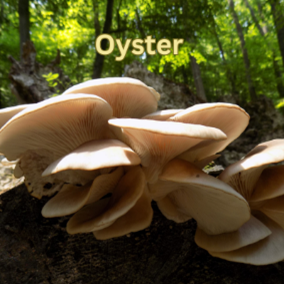Top 10 Edible Mushrooms and How to Identify Them
- Naughty Lani

- Nov 8, 2024
- 2 min read

Introduction
Mushrooms are a delicious and nutritious addition to any meal, but when foraging in the wild, it's crucial to know which mushrooms are safe to eat. Here are the top 10 edible mushrooms and some tips on how to identify them.

1. Morel (Morchella spp.)
Identification: Morels have a distinctive honeycomb appearance, with a pitted cap that ranges from light tan to dark brown. The cap is attached directly to the stem, and both are hollow inside.
- Season: Spring.

2. Chanterelle (Cantharellus spp.)
Identification: Chanterelles are vase-shaped with wavy, ridged edges. They range in color from golden yellow to orange. They have a fruity aroma, often described as apricot-like.
- Season: Summer to early fall.

3. Porcini (Boletus edulis)
Identification: Porcini have a thick, bulbous stem and a large, smooth, brown cap. The underside of the cap features spongy pores instead of gills.
- Season: Summer to fall.

4. Oyster Mushroom (Pleurotus ostreatus)
Identification: Oyster mushrooms have a fan-shaped cap that can be white, gray, or tan. They grow in clusters on decaying wood and have a mild, slightly sweet odor.
- Season: Year-round, with peaks in spring and fall.

5. Shiitake (Lentinula edodes)
Identification: Shiitakes have a dark brown, umbrella-shaped cap with a thick, white stem. The cap often has a cracked appearance and is slightly spongy.
- Season: Spring to early summer.

6. Hen of the Woods (Grifola frondosa)
Identification: Also known as Maitake, this mushroom forms large, frilly clusters that resemble a chicken’s plumage. It is grayish-brown in color and grows at the base of oak trees.
- Season: Late summer to early fall.

7. Lobster Mushroom (Hypomyces lactifluorum)
Identification: These mushrooms are bright orange-red and have a rough, irregular surface. They are actually parasitized by a fungus, which gives them their unique color and lobster-like flavor.
- Season: Late summer to early fall.

8. Chicken of the Woods (Laetiporus spp.)
Identification: Bright orange and yellow shelf-like clusters make this mushroom easy to spot. It has a soft, porous texture and a mild, lemony scent.
- Season: Late summer to fall.

9. Beech Mushroom (Hypsizygus tessellatus)
Identification: Beech mushrooms grow in tight clusters, with small, white to brown caps and long, thin stems. They have a slightly nutty flavor.
- Season: Fall to early winter.

10. Enoki (Flammulina velutipes)
Identification: Enoki mushrooms have long, thin stems with small white caps. They often grow in clusters and have a mild, slightly sweet taste.
- Season: Late fall to winter.
Disclaimer
While foraging for mushrooms can be a rewarding experience, it's essential to approach it with caution. Many edible mushrooms have toxic look-alikes that can be deadly if consumed. Always consult with an experienced forager or a certified mycologist before consuming any wild mushrooms. If you are unsure about a mushroom's identity, it's best to leave it in the wild. Safety first!
Learning to identify edible mushrooms can be both fun and beneficial, but it requires knowledge, practice, and caution. Always err on the side of safety and enjoy the process of discovering these natural treasures. Happy foraging!
And be sure to check out Naughty Lani's mushroom art designs.




